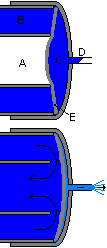Diaphragm valve
A diaphram valve is a pilot opperated valve. It is very similar to a piston valve in therory, but replaces it's hard cylinder with a flexable diaphram.
Opperation:
- Air is added by filling behind the diaphram (C).
- The diaphram (E) is flexed forwards, and seals on the barrel (A).
- More air is added, and leaks around the diaphram (or through a small equilization hole) and into the chamber (B), filling it to the desired pressure.
- The pilot valve (D) behind the diaphram is oppened, the pressure in the pilot volume (C) drops, and the higher pressure in the chamber area pushes the diaphram off the barrel.
- The air flows around from the chamber, and into the barrel, propelling the projectile.
These valves are often used on coaxials and over/unders. In an over/under, the valve is built in a "T" fitting. The barrel is put coaxial through one end, the pilot and diaphram are put in the opposite one, and a chamber is conected to the perpendicular opening with a 90° elbow.
The preformance of these valves can be calculated with the GGDT. If your valve honks, it is probably a good idea to invest in a better pilot valve.
